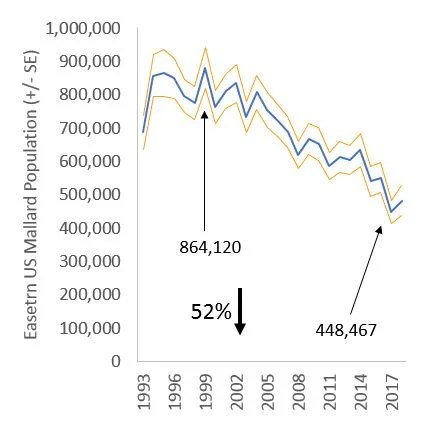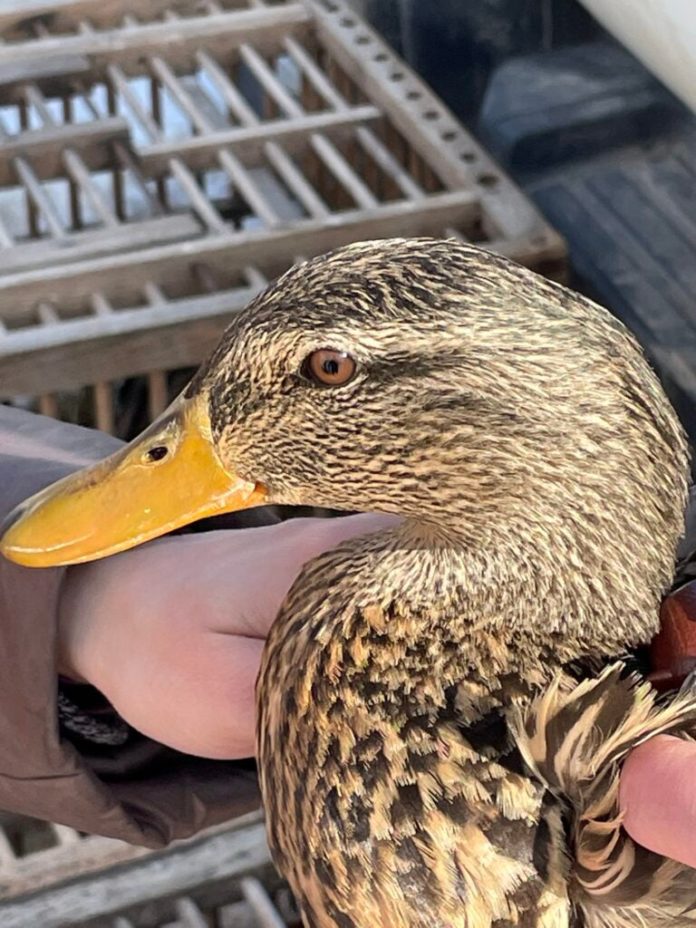This winter, about 300 Atlantic Flyway hen mallards will migrate north with a Global System for Mobile communication (GSM) transmitter affixed to their backs as part of a multi-year study aimed at understanding why mallard numbers are dropping across the Northeast. Over the next four years, a total of 1,000 hens will be tracked using these transmitters to determine demographics, migration chronology, and habitat usage between the Northeastern U.S. mallard populations and their eastern Canadian counterparts (there are two separately surveyed populations of Atlantic Flyway mallards).

By late February, 267 birds had been outfitted with GSM transmitters on their wintering grounds. As the birds migrate north to the breeding grounds, the GSM units will deliver valuable data points.
“Ultimately, this study will help inform our management and understanding [of] where there maybe are problems with what we’ve seen with Eastern mallards, especially in the northeast U.S. over this 20-year decline,” says Josh Stiller, game bird biologist for the New York State Department of Environmental Conservation.

Current research shows that the Northeastern U.S. population has dropped by about 36 percent over the past two decades. The eastern Canadian mallard population remains “relatively stable,” according to the Eastern mallard telemetry study objectives Outdoor Life obtained from Ducks Unlimited. While there are theories as to why this decline is occurring — habitat loss for nesting, genetic differences between wild and game farm (domestic) mallards, and higher harvest rates before a two-bird daily limit was put in place in 2019 — none have been proven. This is mainly due to the fact that Eastern mallards have not been widely studied. Most mallard research has focused on the Prairie Pothole region, the main nesting grounds for Mississippi and Central Flyway mallards and many other species of mid-continent puddle ducks and divers, according to John Coluccy, director of conservation planning for DU.
“We don’t really know what that trajectory looked like on the population prior to the 1990s,” says Coluccy, which is when biologists began tracking Eastern mallard numbers. “We only have what’s going on now. And what we’re seeing now has been a substantial decline [in the Northeastern U.S. population].”
Researchers anticipate using the data collected over the next four years to bridge current gaps in Eastern mallard breeding and nesting metrics and establish a better understanding of mallards in the northeast U.S. and eastern Canada. This is the first ever large-scale study of Eastern mallards; it covers a massive area, from northern Canada to South Carolina. Once completed, the information collected will be used to create a strategic management plan for Atlantic Flyway mallards, which would include a review of daily bag limits for hunters by U.S. Fish and Wildlife.
“The amount of data that’s going to come out of this project really is staggering,” says Stiller. “It’s millions of data points and we just don’t have any data like that right now. There have been a lot of small-scale studies, but this study encompasses the entire northeast and eastern Canada.”
How Are the Ducks Captured?
The ducks are captured using baited walk-in and swim-in traps. Once inside the trap, birds can’t find a way to get out. Other capture methods include rocket nets, which Stiller says “are pretty exciting” as they have three to four rockets that bang as the net expands to capture a flock of ducks in an area of 40 by 60 feet. Once captured, the ducks are put into crates where researchers measure the bird’s bill, head, tarsus (leg bone) and pluck some feathers to assess whether a bird has the game farm genotype or is a wild mallard (researchers can also determine where a mallard was hatched through isotope studies of flight feathers).
“You can run all of these regression analyses and look at the relationships between body size and survival, body size and productivity and understand what makes a successful duck,” says Stiller, adding that because weight is an important indicator of immediate health, the transmitters being used weigh less than 3 percent of the bird’s body weight.
“You don’t want to put something on that’s going to be an anchor around them that’s going to affect both their productivity and survival movements.”
GSM Transmitters Will Produce More Reliable Data Than Bird Banding

The data collected from the GSM transmitter bands is different from the information collected using bird bands. Bird bands are an important tool for population estimates and migration corridors, but not as reliable as transmitters because they require someone to find the band—either a hunter killing a duck or a birder finding a dead one. Bands can also be lost due to duck predation or if a bird dies and is never found.
GSM transmitters are solar powered and download 24 data points per day, allowing biologists the ability to track the birds in real-time when they are in cellphone tower range. But even if they are out of range, once they return to tower range, the data points download. Additionally, each GSM transmitter is outfitted with an accelerometer, which allows biologists to know the “orientation of the transmitter at all times,” says Stiller. This means biologists can tell whether a bird is feeding, flying, resting, or nesting.
“You get this really interesting full annual life cycle picture of what the bird did, and you have it with a really large sample size, which allows you to understand what’s going on in this population and how successful they are at raising young,” says Stiller.
Read Next: Our Obsession with Greenheads Is Ruining Duck Hunting as We Know It
Managing the Mallard Population

That sample, once completed, should have enough data gathered from approximately 1,000 hens to use for large-scale habitat management of both public and private land and to help identify possible stressors or issues impacting the sustainability of healthy mallard populations. This, in turn, will help with population management and harvest strategies going forward.
“The largest threats to black ducks and mallards is habitat loss and degradation across their range,” says Coluccy, noting that urban development and agricultural production have been the main disruptors across historic wetland drainage along the Atlantic Flyway.
“Conservation programs on public and private lands emphasize protecting remaining wetland habitat through title acquisition and conservation easement programs in key areas,” says Coluccy. “Our studies will help identify some of these key areas on breeding, staging, and wintering grounds.”
Current wetlands conservation projects involve either nonprofits or wildlife agencies purchasing private land for restoration purposes or have organizations like DU working directly with landowners on “plugging ditches and breaking subsurface drain tiles to restore the natural hydrology that once occurred,” according to Coluccy. Other efforts include installing or replacing water level management structures like low-level berms or pumps and removing invasive plants that choke out beneficial native plants that waterfowl and other wildlife depend on.
“Once we get to these habitat selection models, then the U.S. Fish and Wildlife Service and the Canadian Wildlife Service (CWS) can take our habitat models and then do some sort of prioritization to determine the core or the most productive habitat for mallards,” says Marie Racioppa, a PhD student at the University of Saskatchewan, who has assisted in affixing GPS transmitters on the first group of mallards. “This would benefit all waterfowl or other ducks specifically that share similar habitat.”
Racioppa will be creating the habitat selection models that will be used for these conservation planning efforts. Each participating state and CWS will have ownership of the data collected from the transmitters that they funded in the study.
The timing of this large-scale Eastern mallard study coincides with a similar study happening with American black ducks in eastern North America, which is funded by the Black Duck Joint Venture. That project will study about 500 birds in the Atlantic Flyway over the next few years with particular emphasis on the reproductive period in the boreal forest, according to Mitch D. Weegman, DU Canada endowed chair in wetland and waterfowl conservation at the University of Saskatchewan.
They aim to compare movements and behavior throughout the year to pinpoint differences in strategies between mallards and black ducks, like migration, use of stopovers, and more, says Weegman in an email.
“The species are so similar, but it seems likely there are very small differences which could cascade to the different population patterns we see,” he says.
Together, these two projects will allow wildlife agencies from multiple states and national organizations like DU to “explore interspecific competition between mallards and black ducks at an unprecedented spatial and temporal scale” never done before, according to the study’s objectives.


